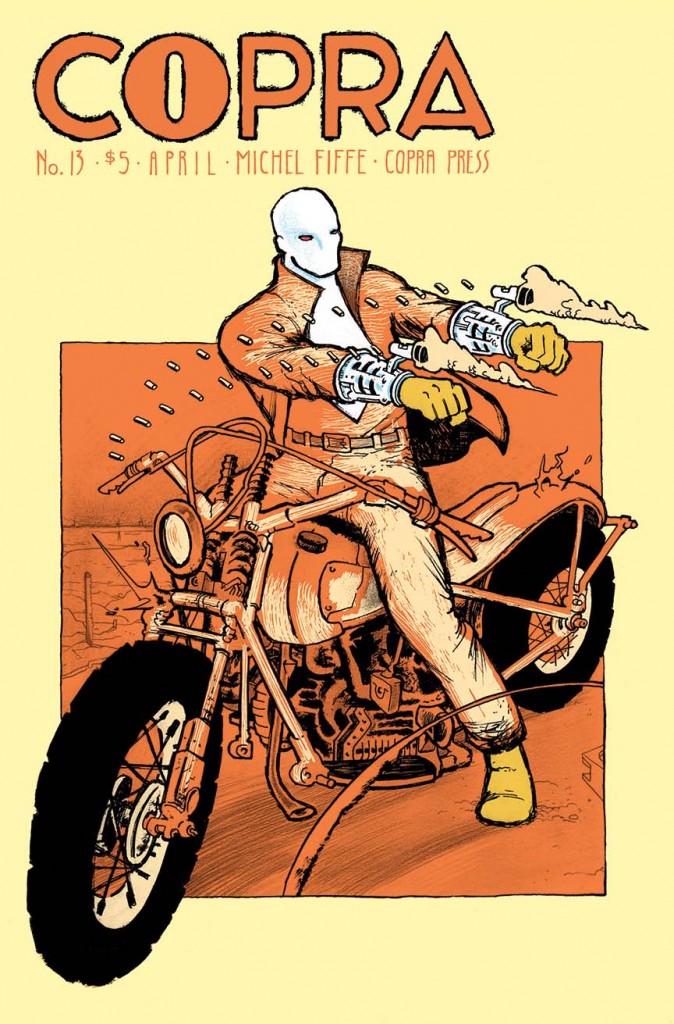
Continuing on from our first entry this past Friday, here is the second part of my HeroesCon interview with Michel Fiffe, creator of the self-published and much lauded action-adventure comic, COPRA.
It’s funny, the way I discovered your work actually came through a friend of mine at first, as a word of mouth sort of thing. Then I firmly jumped in when Oliver Sava starting writing about it on the A.V. Club, and you ended making a ton of these “Best of 2014″ lists, which is pretty exciting right? That sort of vindication has to be rewarding.
It’s nice, it’s nice that people like it, absolutely. Oliver’s a great supporter.
Everyone wants to make a superlative list at some point, right?
Yeah, that means a lot to me personally, and it actually translates into more readers. I think word of mouth has really worked a lot on COPRA, without any huge marketing muscle behind it. That’s been the primary thing, people are just excited about it, and that’s super flattering. To like it so much – in today’s aggressive marketplace – that they spread the word out of genuine enthusiasm… what more could you want?
That’s literally what’s happening, though the only hurdle is, of course, availability.
That’s the only hurdle right now. Bergen Street Press has been working hard for a couple of years now to get over it. We don’t want to make it super exclusive, this isn’t a super limited boutique item by any means, but it’s also not as simple as pushing a magic button for books to suddenly appear. Others have that magic button.

When you made the collections, which have obviously been a great way to pull in readers, you went with Bergen Street Press, and that’s Tucker Stone’s outfit right?
Yeah, that’s Tom Adams and Tucker Stone, they’re co-owners of the store, Bergen Street Comics and they started publishing and putting out “compendium” collections of the issues early on because I started selling out of the issues. So they met that demand, they helped me meet that initial burst of enthusiasm. I was too caught up creating the next issue. My financial model is that one issue pays for the next, there’s no room for reprints, that’s not within my budget. Bergen really helped make it more available and more accessible to people. The compendiums led to an official collection, the current “Rounds” as they’re called, which collects six issues at a time. That’s the kind of thing that we’re trying to get into all the comic shops across the country.
It’s showing up in stores in Atlanta, and I even think I saw copies in the UK over Gosh Comics perhaps.
Yeah, we get a lot of orders from all over the world.
Did you just have a relationship with Tucker and Tom, is that why you went with them as the distributor and publisher and go-to guys?
I trust them and respect them, and I couldn’t happier with that specific team of players. Their point of view and their involvement with the comics industry is something I can get behind.
In regards to availability though, is digital not in the cards?
It’s not NOT in the cards, it’s just something I still have to manage and deal with. There are just so many issues with it, the platform, the way it looks, the time to get everything in order. I’m still dealing with the print issues, that’s a huge thing for me, just getting one of these out every four to six weeks. I barely have any time to do anything else BUT this issue. When it comes to digital, I want to be as hands-on as possible, and that’s a time sucker. I wouldn’t rule digital out, but at the moment it’s not a primary concern. Having said that, I don’t want to exclude anyone from reading it, I understand there’s a large portion of the readership that’s gone digital because its more convenient, but personally I haven’t related to that model. So, it’s not a priority. I don’t feel like it’s something that’s burning in me to address anytime soon.
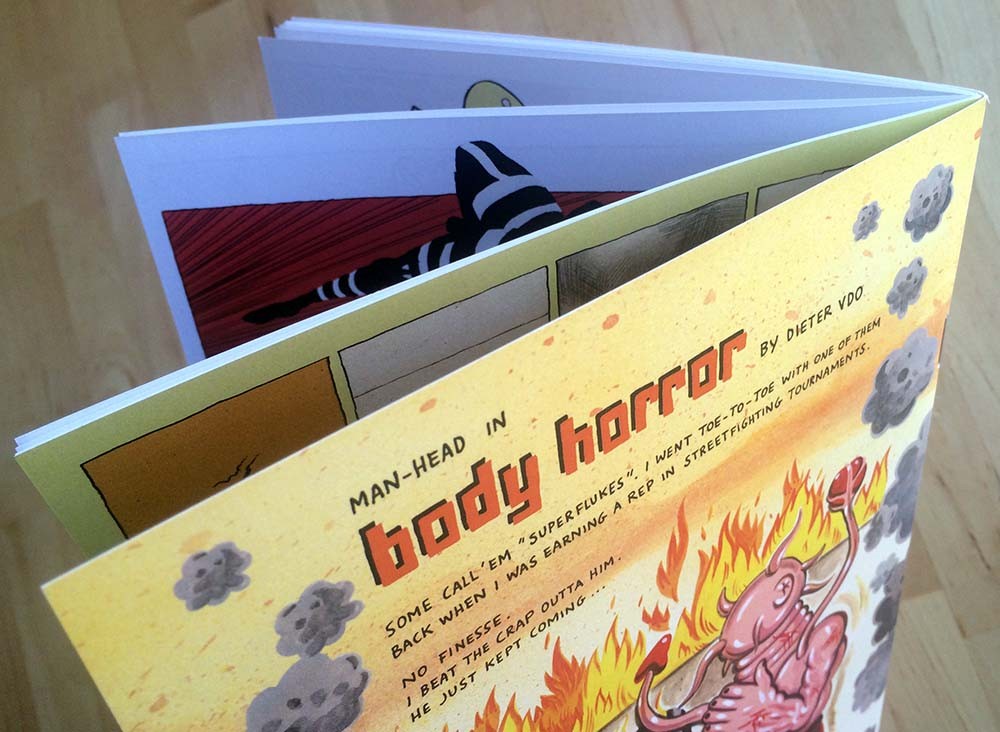
But there is an argument you made yesterday (on a panel with Klaus Janson) about the visual of the comic as a physical object. When you go digital, you do lose that. I mean, you can put everyone of those pages, including the back cover and back matter into a digital copy, but it’s not the same.
It’s not the same, and I want to be clear that I don’t want to impose my fetish of the newsprint comic on anyone. But readers do have the option to buy the issues or NOT to buy them, and that’s the risk I take. I’m not forcing people nor am I trying to change the industry “back to the glory that it was”. I’m just doing this because it’s a model that I’m familiar with and I aesthetically like. It’s a much more intimate thing. I just don’t read that many digital comics. That’s not how I absorb this stuff. I would feel weird putting it out in the world if I’m not sure of it myself.
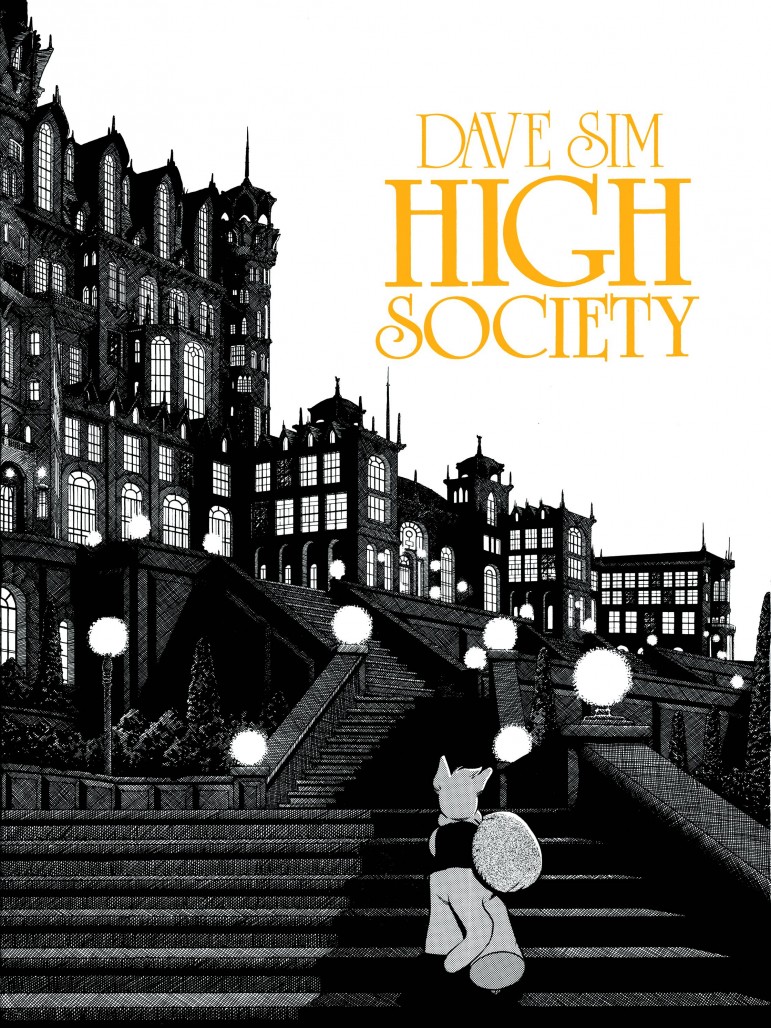
The comparison has been made, and COPRA has been compared very favorably to works like Cerebus, and that’s a comparison that I find to be really quite apt in that you’ve taken an analogous set of characters, like Dave Sim did with Conan the Barbarian, but by Round Three, you’ve expanded that world and its character set in a way not dissimilar from his work in “High Society”. Is that a comparison that you find interesting?
It is, mostly because Dave and I were born on the same day.
Really?
Yeah, so it just means we’re both stubborn and hard headed, and we’re gonna do what we want no matter what. But the COPRA/Cerebus thing… I imagine it’s more accurate than I’d like to think, but the main difference is that Cerebus started out as a parody. And my book…well, I personally fucking hate parody comics of that nature. I like Cerebus, but I especially mean modern indie takes on this sort of stuff. It’s low hanging fruit. You’re going to make fun of superheroes, good job, you’re wasting your precious time on earth doing that. Who cares? You’re not gonna outdo Marshal Law. I love that comic to death. There was a lot of anger behind that book, but it didn’t look down at anyone. Now, you either like superheroes or you don’t, and it’s perfectly fine to dislike it. In fact, you probably shouldn’t. I have zero interest in making fun of this stuff. From the first page of COPRA, it was serious business to me, serious business while fully realizing and basking in the absurd nature of this material.
That’s a difficult balance to achieve – seriousness without being overtly grim.
I just don’t want to wink at readers. I respect the readership too much to be winking at them – like, hey get the joke? Isn’t this DUMB? It’s like, fuck that joke, it’s a terrible joke. And I think Dave Sim wised up to it early on, because he was parodying Conan and the goofy barbarian genre, but then it took on a different identity all together.
 And I feel like that’s where you’re headed too. Round 3 is stunning, and I think when it hits a collected edition, I think there’s going to be a lot of talk. I don’t know how else to put it. I don’t want to speak too highly here, but I think that’s going to be when – people already notice it, but I mean, my god, that chapter when Wir goes back home…
And I feel like that’s where you’re headed too. Round 3 is stunning, and I think when it hits a collected edition, I think there’s going to be a lot of talk. I don’t know how else to put it. I don’t want to speak too highly here, but I think that’s going to be when – people already notice it, but I mean, my god, that chapter when Wir goes back home…
Yeah, that’s a favorite. I was worried about making that one too because it’s so bizarre, even within the norms of COPRA, you know?
It was so touching and so raw. It struck nerves for me. And then Gracie in Miami, and you’re working out some of your own feelings about the city and you even say as much on the back end.
Yeah. Every issue pretty much has at least one autobiographical component in it. And I find that interesting when I read older comics too, whether they meant it or not, I think it comes through. Especially for the older creators who really had no other option but to express themselves through The Brave and the Bold or something. But for me to actually write this stuff, I have to put some sort of personal experience in it. So every issue, there’s something there that’s really personal. But I also don’t want it to be too obvious, though.
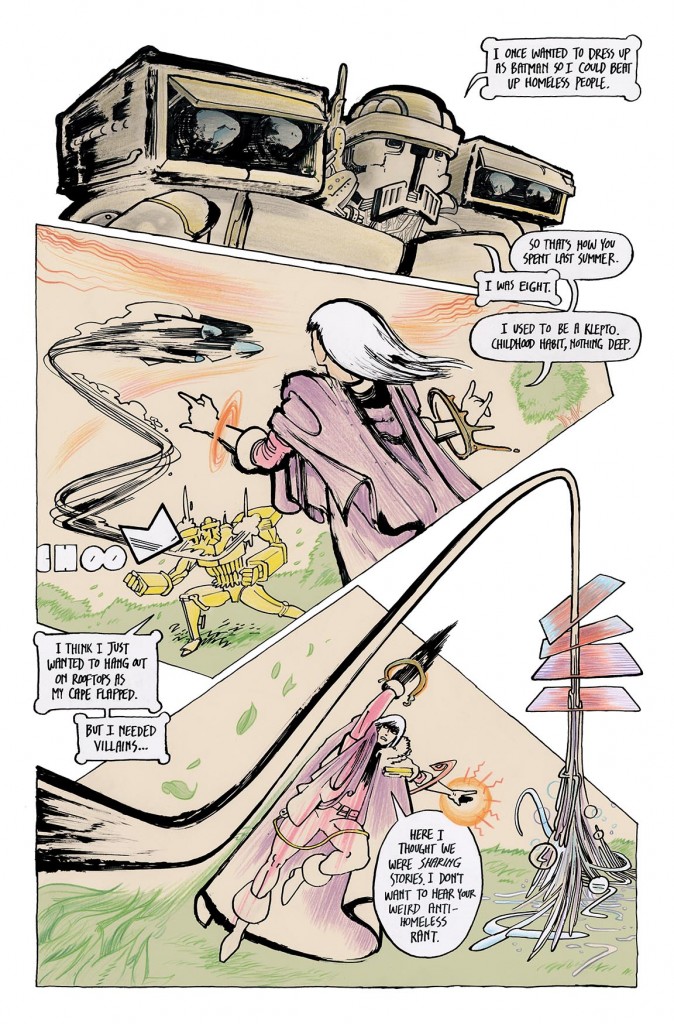 Let’s talk about Round Four or the presumed Round Four, about what’s coming up, what’s being developed. Spoiler alert: Dutch got it at the end of the latest issue. And clearly there’s another team that’s sort of gaining up on the COPRA side of things. At least that’s what it seems like. There’s an organized group of evil doers. What can we expect in the next couple of issues; I think there are two left in this round?
Let’s talk about Round Four or the presumed Round Four, about what’s coming up, what’s being developed. Spoiler alert: Dutch got it at the end of the latest issue. And clearly there’s another team that’s sort of gaining up on the COPRA side of things. At least that’s what it seems like. There’s an organized group of evil doers. What can we expect in the next couple of issues; I think there are two left in this round?
I have two left. And then I’m going to have a 25th issue anniversary-sized thing, that’s going to stand apart from the narrative, the main arc. And then starting with issue 26 that starts another arc all together. I’m going to work in six issue chunks, but there are going to be main storylines in that. I think I’m going to go up to fifty issues, so 25 will be an anniversary issue, as well as the halfway point.
So there will be an endpoint that’s set in stone?
Yes, I do have an ending set, I’ve mapped it out that far. I’m so excited for it. Knowing that it’s going to end and that everything is building up towards it makes every step of the way that much more fun for me, much richer.
So what can you tell me that we can expect in just very general terms, without spoiling anything, for the next two issues? Is it going to be a battle between the team and this group of guys that are coming after them?
It’s going to be COPRA vs COPRA. That’s all I’m going to say.
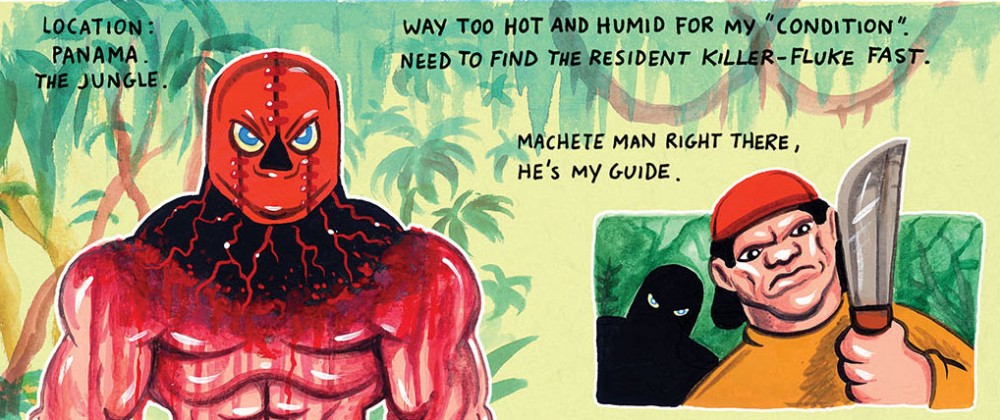
You’ve got two other narratives occurring in these books, you’ve got Dieter VDO’s back cover story for Man-Head…
Which is non-canonical.
Let me ask you how that got arranged first. Are you and Dieter friends?
Oh, I’m a big fan of his work. He did a Savage Dragon story for this collection of back ups I edited. This was ages ago. Anyway, Dieter… I like spreading the word on him. I think he’s great, one of my favorite cartoonists. I wanted to have unique back matter for this current arc and he was the first person I thought of to do something. Instead of pin ups, though, I wanted a serialized narrative. Thankfully he was on board. His own weird version of COPRA? Who wouldn’t want to see that?
So what is going on between your narrative and his narrative in these orange and white pages? There’s something appearing in the sky…?
Oh, that. Well, that’s a subplot that has to do with Rax’s dimension. It’ll all make sense once you read it together, there IS a point to it; it’s not as arbitrary as it seems. I’ve been playing it quietly because if I show too much, it’ll spoil things.
When can we expect the next issue to hit?
Maybe 4 weeks, a month? After the show I’ve to get back to drawing it. I’m not really ahead, schedule-wise. As soon as the issue is done, it’s practically in the readers’ hands.
You can purchase recent issues of COPRA at Michel Fiffe and Kat Roberts’ Etsy store. While Bergen Street Press is currently sold out of both collected editions of the series, you can purchase the first collection at InStockTrades.
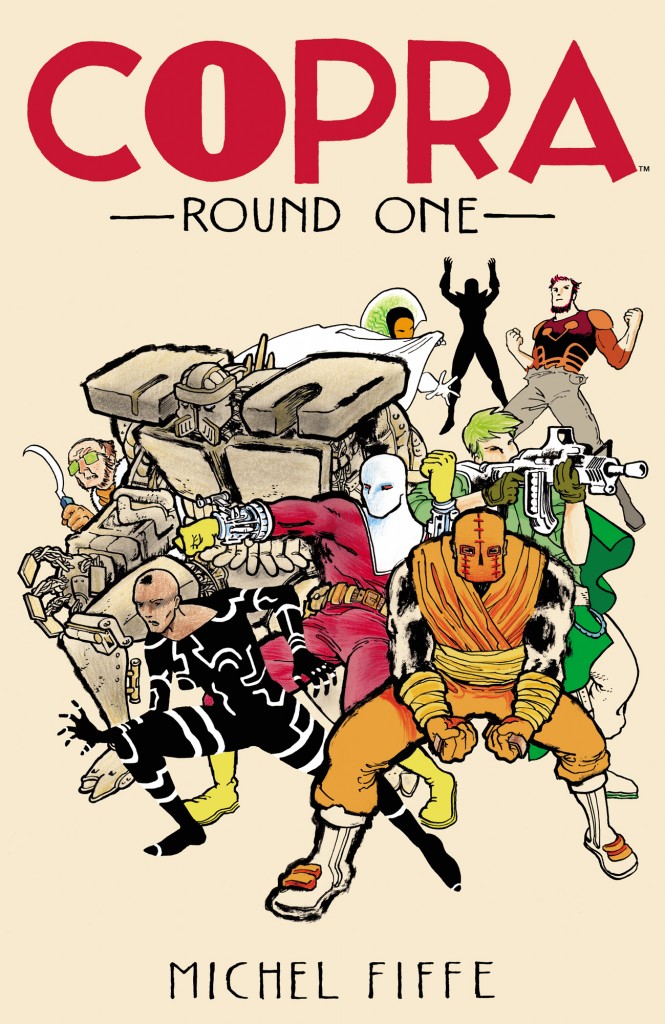
For me, COPRA is the one of the few superhero comics that really matter.
A few years ago, I was at a point where I had basically given up on everything produced within the arena of the “Big Two”. Sure, I enjoyed the occasional Grant Morrison comic when they would rear their head, but for the most part I had lost the exhilaration I used to get when I would read the adventures of my favorite costumed adventurers. Then, in the midst of a discussion of Jack Kirby and John Ostrander, a good friend floated along the idea that I would find great delight in reading the self-published wonder that is Michel Fiffe‘s riff on Ostrander’s biggest legacy work. What I found was a comic that embraced everything I loved about superheroes and the ideas of some of their most iconic creators, and then spun them off in wholly exciting and unpredictable directions. The jubilation that I feel whenever I crack open a new issue of COPRA is likely on par with what readers in the 70’s felt when a new Fourth World installment was released, or their counterparts in the 80’s when the aforementioned Suicide Squad and Watchmen were being unfurled upon an unsuspecting public.
COPRA reminds me of the actual potential of this side of the medium, and it’s a book that I wish everyone had their hands on. It is superhero comics at their absolute best.
While at HeroesCon, I had the opportunity to sit down with Fiffe to discuss what’s coming up in his lauded series along with other points of interest that encircle self-publishing and the day to day process of creating the issues in which he is responsible for every facet, including their mailing to subscribers. Here is Part 1 of our discussion:
When you conceived of COPRA, what was the impetus to say: “I’m going to self-publish this and do everything myself” vs. pitching it to a publisher like Image or Boom! or any other publisher that might have found a home for it?
I find the pitching process to be rather exhaustive and time consuming. I know it well, I’ve done it many times. It’s such a slow process getting a book green-lit and that’s not the nature of what I wanted to do with COPRA. It had to exist almost immediately. I don’t have a committee to answer to and that’s appealing to me. I’m not comfortable giving that power to whatever company.
And you did a lot of pitching before that you said?
Tons of pitching, tons of submissions, I’ve done pretty much everything I could think of to do to get in through the door. I’ve got some published works as a result, but nothing really satisfying, or that I really felt confident about. So, self-publishing, once I started doing that, that’s when I felt like I was creating comics on my own terms. COPRA is a natural extension of that, especially when I started giving myself a monthly schedule, mimicking the schedule of mainstream comics. For me, that’s the interesting dichotomy of it, where I’m harnessing this kind of “old-school” rigorous schedule to fit my independent needs.
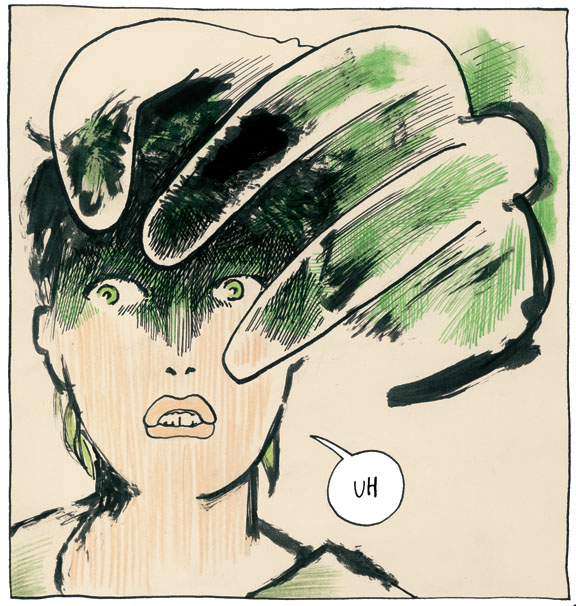 But are there significant challenges you find? I know there’s promotion that would be available in a big house publisher, like if you were working with Image there’d be press releases constantly. Is bandwidth an issue?
But are there significant challenges you find? I know there’s promotion that would be available in a big house publisher, like if you were working with Image there’d be press releases constantly. Is bandwidth an issue?
Well, motivation is always the biggest hurdle to overcome, especially given an unrelenting schedule. I have to wake up every day and treat this like a job, because it IS my job, it is my full-time job. I have to get it done somehow, I can’t wait for the muse to strike. I have to get an issue done a month, or as close as possible. But as far as challenges in not having the marketing muscle of other companies? I’d rather stand apart from the wall of noise. How many press releases does anyone really read, anyway?
Your comics, at least in their monthly form, are only available on your Etsy page and I noticed that you share that with your significant other, I think I saw some nice craft jewelry I think?
Yeah, Kat Roberts sells all kinds of stuff, zines, handmade purses, prints. I totally piggy-backed off her store on Etsy. That was a platform I was familiar with, so when I started publishing Zegas (Fiffe’s first self-published comic) I didn’t have a place to sell it from, except conventions and maybe the occasional store that would take a risk on it. Etsy allowed me to slowly build up my readership. By the time I got to COPRA, there was a significant amount of people that were interested in the stuff I did and that made it easier for me to move forward.
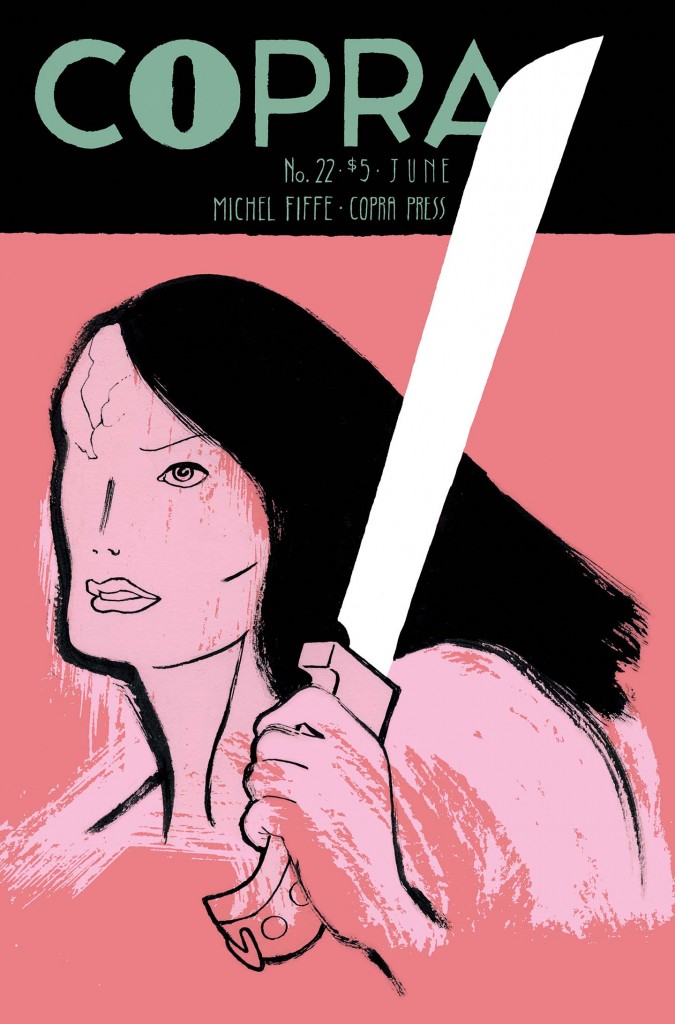 Let me turn to the actual creation process of an individual issue, say you’re sitting at your desk and working on Issue 22 right now?
Let me turn to the actual creation process of an individual issue, say you’re sitting at your desk and working on Issue 22 right now?
That’s the one that just came out.
Good, let’s use that one as an example, if you’re working on Issue 22, what is your step by step? Do you script first and then directly move into the illustration phase? Do you create thumbnails? How do you piece your typical issue together?
It always changes, but the constant thing is that I always map out the story, page by page, and then I script it loosely. Then I start penciling loosely with the first draft in mind. The real work portion of the process begins when I start refining the script while inking and sometimes hand lettering. That’s when it all starts coming together. But generally I have a very loose plan in mind per issue. It’s equal parts organic and strict. I just have to get a number of pages done every day, that’s basically my main objective.
What’s your average rate right now?
Comfortably, I’d say about two pages a day, complete with full color. And that may range, sometimes I may get three, sometimes just half of a page, it just depends. And then you also have to consider the managerial aspect of it after the book is done. I have to get it shipped out to readers and stores and that’s definitely a job in of itself.
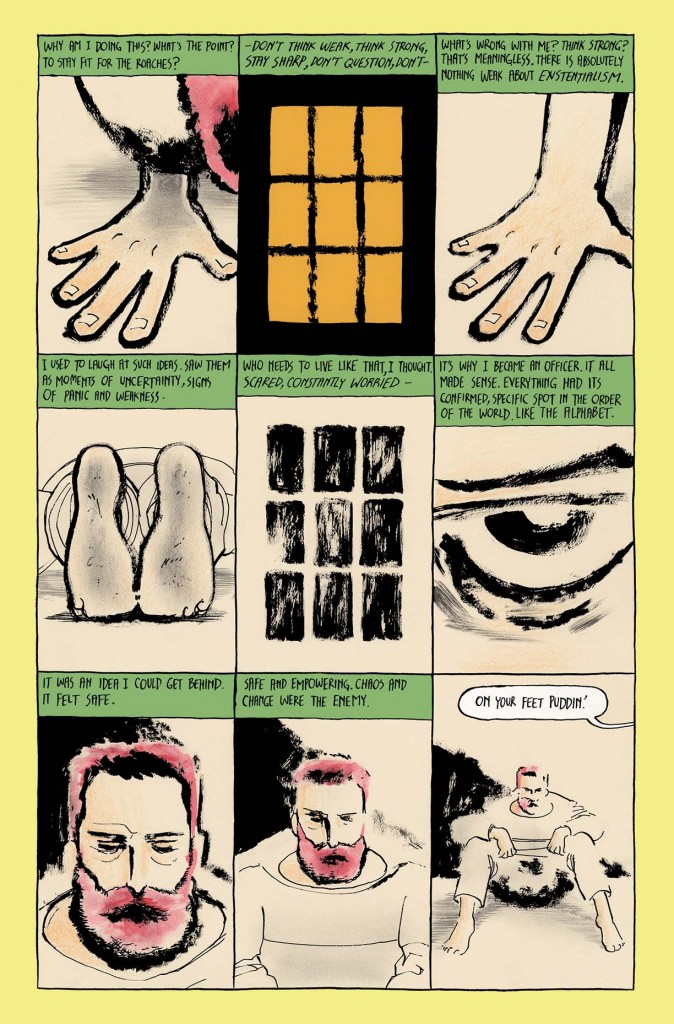
Was there ever a page or spread or a panel layout that was really hard to crack? Was there any particular example where you just said “oh my god, what am I doing with this thing?”
Every page is like that, but I try to make it work somehow. I have to bring that blank page to life somehow. But the trick is to not think about it too much, because if I over-think it – which is my natural inclination – it kills it. You can get caught up in that and then nothing exists, there are no results. I strive for perfection, but being my own worst critic, I have to be real careful to not crush my gut instinct.
You’re a real master of negative space, and I read an issue and think “damn, Fiffe really knows how to use that white”. I think that’s a rare talent, and I’m not trying to kiss ass, but when I read through recent issues it’s hard to not notice how much your craft continues to grow every single issue. I’m floored by the way you use this stuff.
Thanks, man!
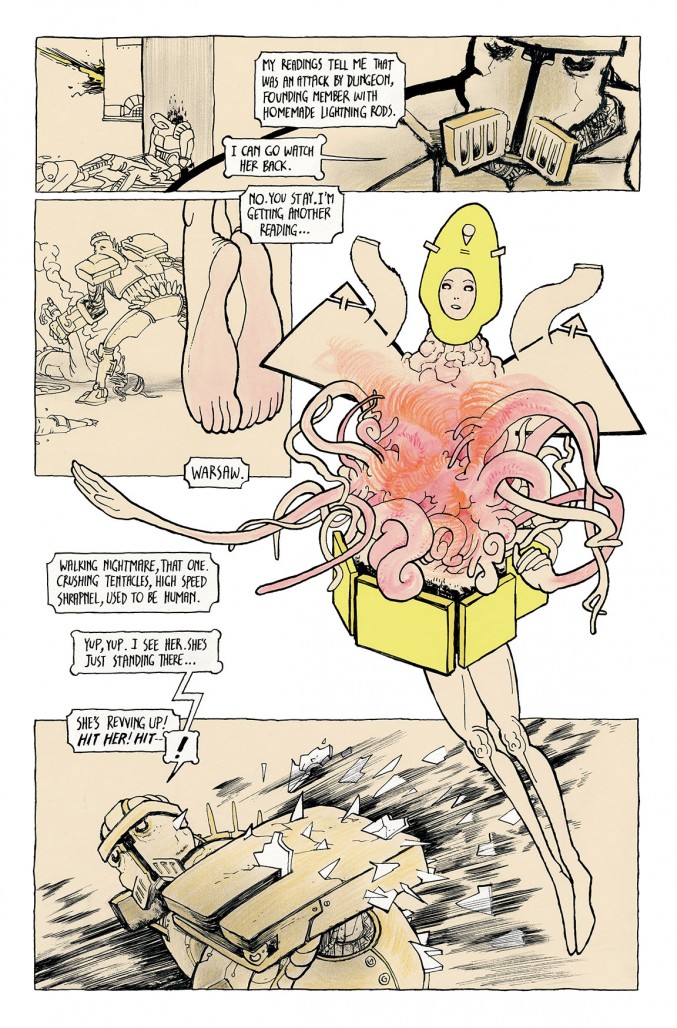 Back to COPRA‘s origins, if I may, when you began to pull together your characters designs and tried to piece together the different teams…and there’s a number of different teams now I guess, you’ve got COPRA, Asesinos…
Back to COPRA‘s origins, if I may, when you began to pull together your characters designs and tried to piece together the different teams…and there’s a number of different teams now I guess, you’ve got COPRA, Asesinos…
Right, it’s all splintered.
Yeah, I almost have a hard time keeping track.
I should map it out.
I would love that, if you would put a thing at the end of each issue with the full cast.
I’ve been thinking about that, actually.
That would be awesome, and I’ll take full credit if it happens. But when you were conceiving of your core cast, there are obviously analogous elements to Ostrander’s Suicide Squad.
Absolutely!
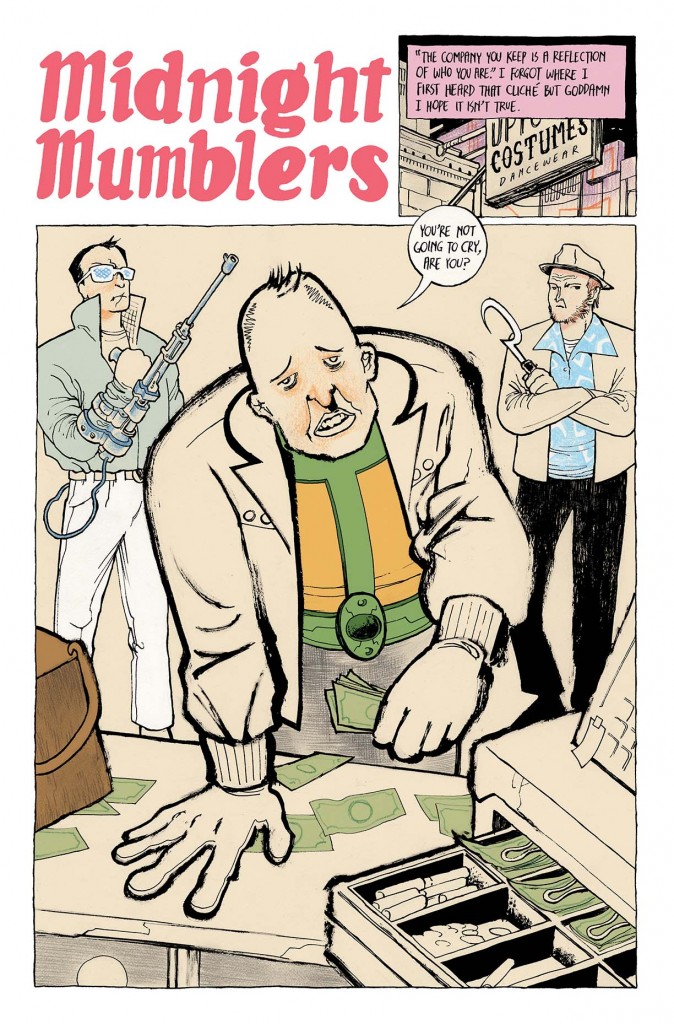 Did you ever find it was difficult to skirt the line between your own original ideas and those aforementioned analogous elements or did you just say, I’m going to use this as a starting point and go my own way?
Did you ever find it was difficult to skirt the line between your own original ideas and those aforementioned analogous elements or did you just say, I’m going to use this as a starting point and go my own way?
When I initially set out to do this comic, I put myself in the mindset of: “what if a publisher hired me to take over a title, and gave me complete freedom”, which would never happen in the current landscape. So using that fantasy to guide me, I took the Dirty Dozen-esque concept, which has been around for a while in many different forms, and I used it as a blueprint to work from. I wanted a world I could really sink my teeth into month in and month out. I wanted to make something that was serialized, that maximized the nature of the single issue, I wanted to build a place that made it easier for me to explore all my interests. The analogous aspect of it… I was reluctant at first, but I had forgotten that some of my favorite comics are analogous, too, some more blatant than the others.
Are there any examples you can cite? At least of the ones that fall favorably with you?
I mean, the Fantastic Four included a Kirby monster, Plastic Man, and Carl Burgos‘ creation as the Challengers of the Unknown… as a response to JLA. Watchmen, Marvelman, Supreme, everything Alan Moore does, basically. That’s no secret. So I moved forward citing those comics, using the current cultural momentum of irreverence to just do whatever I want. Plus, I figured no one’s going to be reading this anyway! We’re talking small press here, not many copies exist. It was liberating.
How far ahead did you map out your story?
Not that far, I did it issue by issue. I also wanted it to feel like a very immediate, raw, I wanted it to be as direct a thing as possible. So, it was really just one or two issues ahead. I mapped out twelve issues with super brief descriptions and that’s all I had to go on. I also wanted to make sure that I could fill twelve issues worth of stories. Luckily it worked out.
Look for Part 2 of our discussion on Sunday, when we discuss the possibility of digital distribution and what readers can expect in upcoming issues of COPRA.
You can purchase recent issues of COPRA at Michel Fiffe and Kat Roberts’ Etsy store, or you can order. While Bergen Street Press is currently sold out of both collected editions of the series, you can purchase the first collection at InStockTrades.
by Harper W. Harris
Kevin Wada has been one of my favorite cover artists since he started on She-Hulk; it was one of those rare but wonderful circumstances where the cover artist seemed to really play a key role in the creative team, and his unique style was part of what made that book such a standout. Since then he’s gone on to provide covers for many series and continues to become more and more of a fan favorite. HeroesCon 2015 kept him busy and his commissions list full, but I got a chance to have a brief chat with him on Sunday about his interesting path to comics, his process, and what to expect in the future.
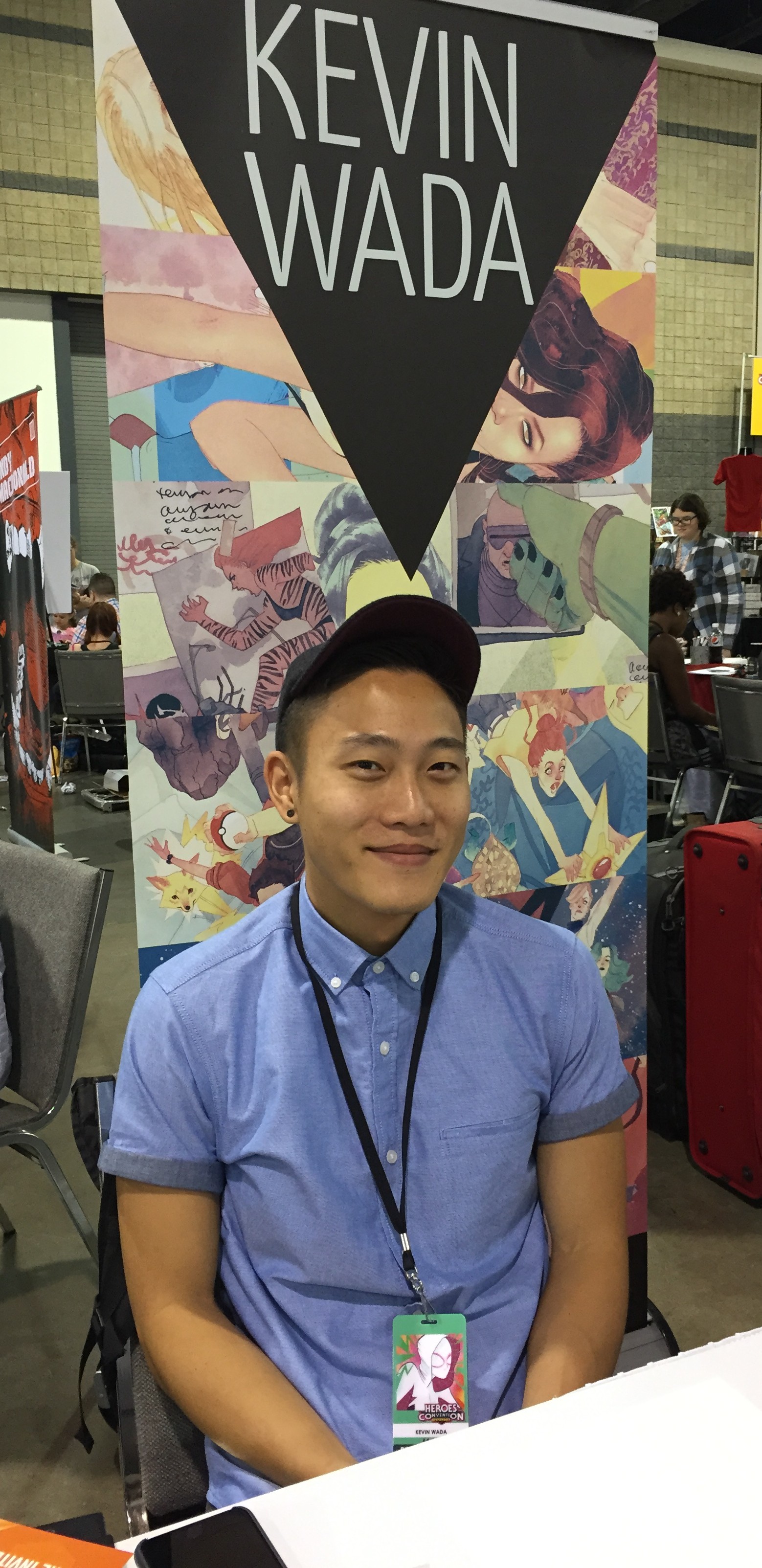
Kevin Wada at HeroesCon 2015
Harper W. Harris: We are here with Kevin Wada, one of my absolute favorite artists and the cover artist of some of my favorite books. How is your con going?
Kevin Wada: I am doing great, I feel re-energized and I’m ready to end the con on a strong note!
HH: You have a really interesting story about how you came into comics from outside of the comics industry, could you elaborate a little on that?
KW: I had done this series of X-Men as fashion illustrations and it went viral. Because it was popular I continued it, making more ambitious projects. When the new X-Men team launched and it was all women, I did an illustration of that. I think this is what happened: Brian Wood bought a print of that from my store and I tweeted to him like, “Thank you!” and I think he passed my name along to editors at Marvel. Then I got my first X-Men variant and then the editor that I worked with who was amazing really wanted to get me on an ongoing book and that’s how She-Hulk happened.
HH: Have you been a fan of comics your whole life? Were you an avid reader or did you come to it from more of the art side of things?
KW: I always say I was sort of orbiting ‘planet comic’. My cousin was really into comics, and he was like my best friend growing up, so I always had this very loose handle of superheroes and all that kind of stuff. I loved it–I loved it aesthetically, I loved the drama of it all–but I wasn’t a hardcore reader, it was very, very casual. So I have this nostalgic affinity and it kind of makes me feel very comfortable. But I’m not going to know the history of every single character.
HH: You have a really unique style. Can you talk a little bit about what your process is and what your materials are?
KW: I work in watercolor, but other than that it’s a pretty straightforward process. It’s pencils to either colored pencils or pen on top of that, and then I use the watercolor to flesh it all out. Often, but not always, there’s some digital editing going on. It’s not unlike retouching a photo–I’ll correct colors, I’ll correct like if an eye looks a little wonky I’ll fix that. One thing I usually have to correct in the computer is my sense of value, my sense of value is horrible. I’ll push my lights, I’ll push my darks, and really make the image pop.
HH: You work primarily as a cover artist with some of the most talked about covers in the industry. What is your creative process for coming up with an idea for a cover? Do you typically know a lot about what the content of the issue is going to be before you start?
KW: That really depends on who you’re working with and what their schedule is, and if they’re on top of things. I’ll often get a one sentence synopsis and a one sentence concept that they want me to push, and then you kind of just have to go. It’s kind of scary because you have this really horrible idea of what the story is or what the themes are, so luckily it’s just one issue and then you’re on to the next one!
HH: One of the things I love about your covers is that you’ve got a great ability to tell a story with a single, wordless image. Do you have an interest in pursuing that kind of storytelling in interiors, from a panel-to-panel perspective?
KW: We’ll see, it’s a totally different beast. I haven’t flexed that muscle since college. I don’t know how good I’d be at it–I’m down to learn, I know it’ll be a lot of work and that’s scary because I’m very lazy (laughs). So I don’t know, we’ll see…time will tell.
HH: Where can people find your stuff, and what are you working on now that you’re excited about?
KW: You can find me @KevinWada everywhere, Tumblr, Instagram, Twitter, I’m on Facebook but I don’t really use it. Coming up is a lot of Catwoman covers and a lot of DC variants, they’ve been throwing tons of work my way. I have an A-Force variant for Marvel, some character designs coming out…that’s about it!
 And I feel like that’s where you’re headed too. Round 3 is stunning, and I think when it hits a collected edition, I think there’s going to be a lot of talk. I don’t know how else to put it. I don’t want to speak too highly here, but I think that’s going to be when – people already notice it, but I mean, my god, that chapter when Wir goes back home…
And I feel like that’s where you’re headed too. Round 3 is stunning, and I think when it hits a collected edition, I think there’s going to be a lot of talk. I don’t know how else to put it. I don’t want to speak too highly here, but I think that’s going to be when – people already notice it, but I mean, my god, that chapter when Wir goes back home… Let’s talk about Round Four or the presumed Round Four, about what’s coming up, what’s being developed. Spoiler alert: Dutch got it at the end of the latest issue. And clearly there’s another team that’s sort of gaining up on the COPRA side of things. At least that’s what it seems like. There’s an organized group of evil doers. What can we expect in the next couple of issues; I think there are two left in this round?
Let’s talk about Round Four or the presumed Round Four, about what’s coming up, what’s being developed. Spoiler alert: Dutch got it at the end of the latest issue. And clearly there’s another team that’s sort of gaining up on the COPRA side of things. At least that’s what it seems like. There’s an organized group of evil doers. What can we expect in the next couple of issues; I think there are two left in this round?














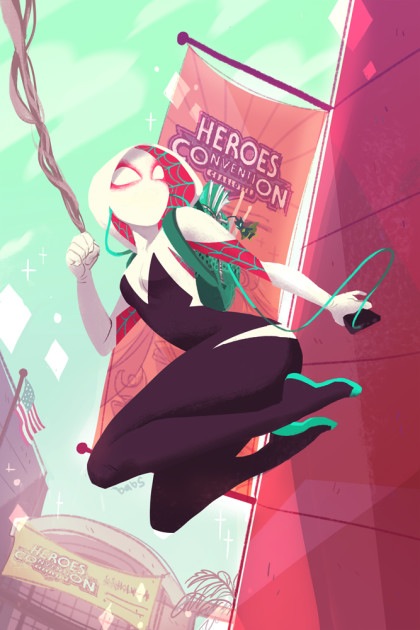
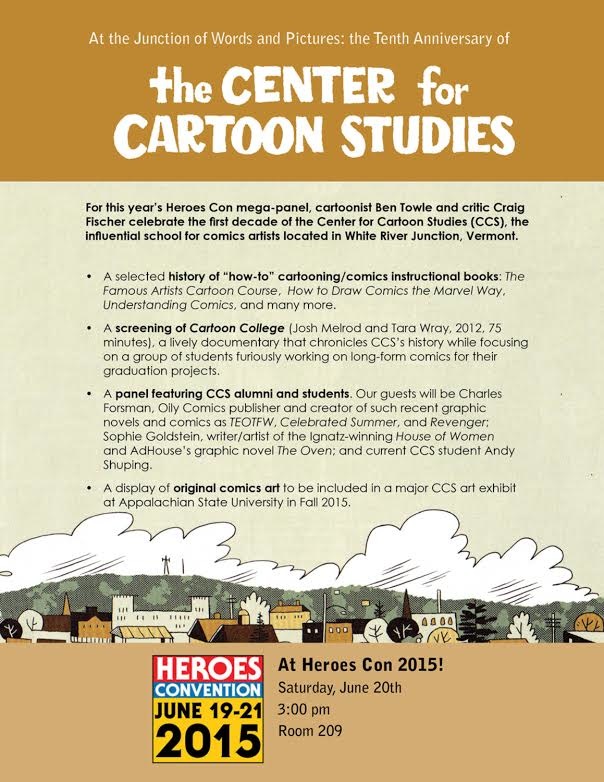
I hear the trepedation about digital release; I always wonder what digital comic sales figures really are… 5% of print? 10% of print?